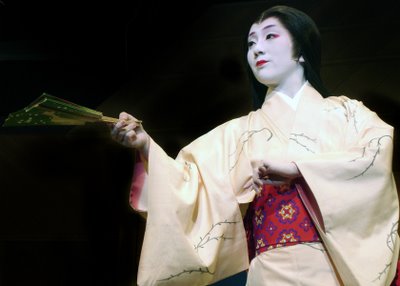 Random picture of the day: A Pontocho geisha perfroming in Kamogawa Odori. Pontocho is one of Kyoto's 5 hanamachi, or geisha districts. This image has absolutely nothing to do with the following post. (^-^)v
Random picture of the day: A Pontocho geisha perfroming in Kamogawa Odori. Pontocho is one of Kyoto's 5 hanamachi, or geisha districts. This image has absolutely nothing to do with the following post. (^-^)vJapan's total fertility rate, an indicator used for international comparisons of birth trends within individual countries, fell for the fifth consecutive year, hitting a record low of 1.25.
At the same time, suicides in Japan topped 30,000 (32,552) for the eigth straight year.
Not a good combination.
Japan's suicide rate is one of the highest in the world-- triple that of Great Britain, and double that of the United States. Suicides started to rise in 1998, when the country was mired in an economic slump. Since then the number of suicides has exceeded 30,000 every year. Males account for more than two-thirds of the total, with health problems and economic woes being cited as the most prevalent causes, respectively.
This year the number of students committing suicide reached 861, up 9.8 percent. University students accounted for more than half of the total, along with 7 elementary school pupils, 66 junior high school students, and 215 high school students .
Japan's cult suicide scene is also growing, with the number of Japanese killing themselves in groups rising steadily in recent years, from 34 in 2003 to 91 last year.
No religious prohibition exists against taking one's own life in Japan, condemning it as a sin or affront to god. Confucianism, in fact, sanctions suicide as a form of protecting one’s honor or protesting injustice. Suicide was once a form of ritual atonement for samurai, a poetic, redemptive act of purpose, considered to be both heroic and beautiful. Today it is a means of escaping failure and saving loved ones from embarrassment or financial loss.














